Oral Health and Cerebral Palsy
Cerebral palsy (CP) is a neuromuscular disorder often accompanied by disturbances in movement, sensation, communication, and behavior. These problems can include changes in orofacial structure, problems with eating and swallowing, and oral self-care. Children and adults with CP have increased incidence of periodontal disease, dental caries, malocclusion, tongue thrust, drooling, gastrointestinal reflux, bruxism, hyperactive bite and gag reflex. Maintaining oral hygiene and accessing appropriate dental care, all of which affect oral health, can represent a health equity challenge.
Oral Health and Cerebral Palsy
Download all files for this teaching strategy
Learning Objectives
Students will:
- Discuss the oral health needs of patient with CP.
- Describe barriers to oral care for patients with CP.
- Identify four questions to ask patient/parent about oral hygiene practices.
- Analyze modifications needed for patient with CP in dental office.
Learner Prework
Have students read the following:
- Cerebral Palsy and Oral Health Issues
https://www.cerebralpalsyguidance.com/cerebral-palsy/associated-disorders/oral-health-issues/
- Practical Oral Care for People with Cerebral Palsy
https://www.nidcr.nih.gov/sites/default/files/2020-10/practical-oral-care-cerebral-palsy.pdf
- Successful Management of Adult Patients with Cerebral Palsy
https://dimensionsofdentalhygiene.com/article/successful-management-adult-cerebral-palsy/
- Trusted Philadelphia Special Needs Pediatric Dentists. https://penndentalmedicine.org/patient-information/dentist-for-special-needs/pediatric-cerebral-palsy-dental-management/
- US Department of Health and Human Services, National Institutes of Health, National Institute of Dental and Craniofacial Research. Dental care everyday: A caregiver’s guide. https://www.nidcr.nih.gov/sites/default/files/2017-09/dental-care-every-day-caregiver.pdf
Suggested Learning Activities
- Using the Trusted Philadelphia Special Needs Pediatric Dentists web page, have students implement an oral health literacy discussion with a patient with CP, explaining three reasons CP affects oral health.
- Using Successful Management of Adult Patients with Cerebral Palsy, have students draw a concept map of the barriers a patient with CP encounters in a dental office and the modifications needed.
- Using Dental Care Everyday: A Caregivers Guide, have students create four questions with brief rationale to ask a caregiver about the oral hygiene practices of a patient with CP.
- Have each student choose one oral health problem from the Oral Health and Cerebral Palsy Nursing Interventions activity and plan nursing interventions for a patient with CP.
Suggested Reading
Bensi, C., Costacurta, M., & Docimo, R. (2020). Oral health in children with cerebral palsy: A systematic review and meta-analysis. Special Care in Dentistry, 40(5), 401-411. doi: 10.1111/scd.12506


